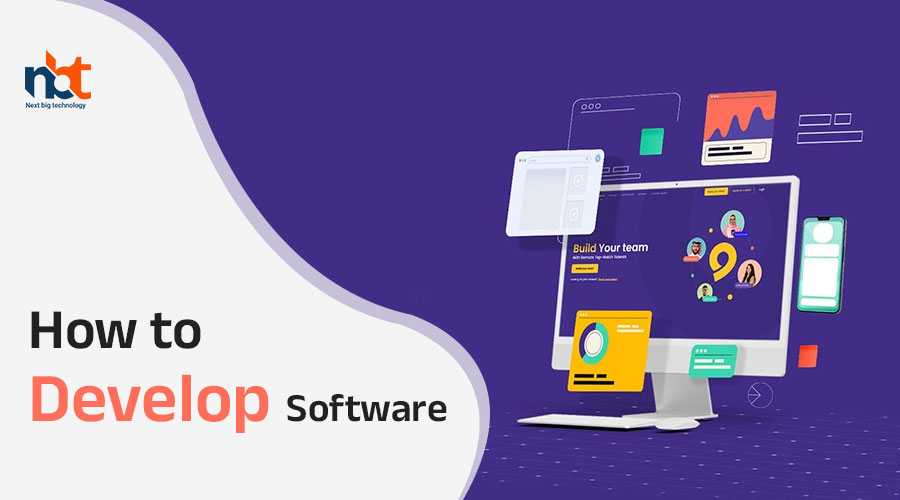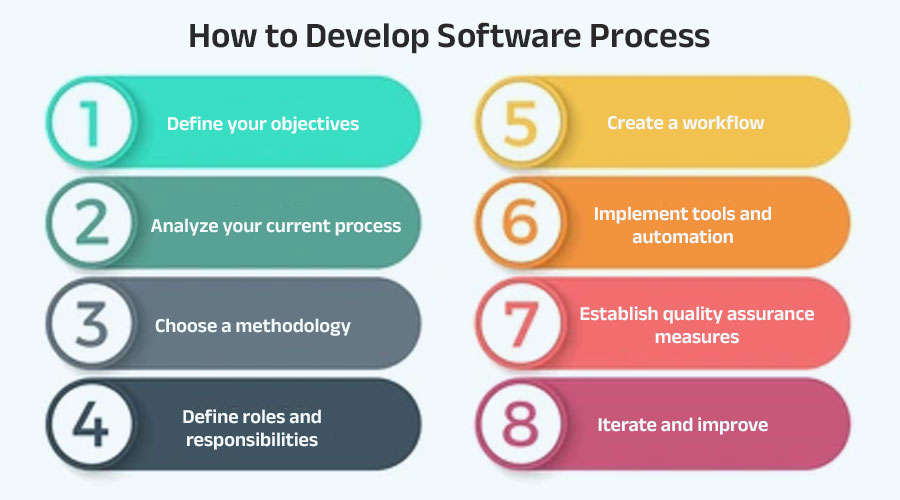Table of Contents
How to Develop Software Services
Developing software services requires careful planning, efficient execution, and continuous improvement. Whether you’re a seasoned developer or just starting out, the process can seem daunting. However, with the right approach and mindset, you can create high-quality software services that meet the needs of your clients or users. Here are some steps to help you develop software services effectively:
- Understand the Requirements: Before you start developing any software service, it’s crucial to have a clear understanding of the requirements. This involves gathering information from stakeholders, conducting market research, and analyzing user needs. The more detailed your requirements are, the easier it will be to develop a solution that meets them.
- Define the Scope: Once you have a solid understanding of the requirements, define the scope of your project. This includes determining what features and functionality the software service will include, as well as any limitations or constraints that need to be considered. Clearly defining the scope upfront will help prevent scope creep and ensure that the project stays on track.
- Choose the Right Technologies: Selecting the right technologies is essential for the success of your software service. Consider factors such as scalability, performance, security, and compatibility when choosing programming languages, frameworks, databases, and other tools. Keep in mind the specific requirements of your project and choose technologies that best meet those needs.
- Design the Architecture: Designing a solid architecture is crucial for building a robust and scalable software service. Consider factors such as modularity, scalability, maintainability, and extensibility when designing the architecture. Break down the system into smaller, manageable components and define how they will interact with each other.
- Develop Iteratively: Instead of trying to build the entire software service at once, adopt an iterative development approach. Break the project into smaller, manageable tasks and prioritize them based on their importance and complexity. This allows you to deliver value to your clients or users quickly and gather feedback early in the development process.
- Test Thoroughly: Testing is an integral part of software development and should be done continuously throughout the development process. Implement various testing strategies, including unit testing, integration testing, and acceptance testing, to ensure that your software service functions as intended and meets the requirements.
- Deploy and Monitor: Once your software service is developed and tested, it’s time to deploy it to production. Implement a robust deployment process that ensures smooth deployment with minimal downtime. Additionally, set up monitoring and logging to track the performance and usage of your software service in production and address any issues that arise promptly.
- Collect Feedback and Iterate: After deploying your software service, gather feedback from users and stakeholders and use it to identify areas for improvement. Iterate on your software service based on this feedback, continuously refining and enhancing it to better meet the needs of your clients or users.
How to Create a How to Develop Software
Creating software can be a daunting task, especially if you’re new to development. However, with the right approach and mindset, anyone can learn how to develop software. In this article, we’ll walk you through the steps to create your own software from scratch.
- Define Your Goals and Requirements: Before you start coding, it’s essential to have a clear understanding of what you want to achieve with your software. Define the problem you’re trying to solve and outline the features and functionalities your software should have. This will serve as a roadmap for the development process and help you stay focused on your goals.
- Choose the Right Technology Stack: Selecting the appropriate technology stack is crucial for the success of your project. Consider factors such as the type of application you’re building, the scalability requirements, and your team’s expertise. Whether you’re building a web application, mobile app, or desktop software, there are various programming languages, frameworks, and tools available to choose from.
- Design the User Interface (UI) and User Experience (UX): The user interface plays a significant role in the success of your software. Design an intuitive and user-friendly interface that allows users to interact with your software effortlessly. Pay attention to details such as layout, navigation, and visual elements to ensure a positive user experience.
- Develop the Software: Once you have a clear plan and design in place, it’s time to start coding. Break down the development process into smaller tasks and tackle them one at a time. Use version control systems like Git to manage your code and collaborate with team members if you’re working in a team. Follow best practices and coding standards to write clean, maintainable code.
- Test, Test, and Test: Testing is an integral part of the software development lifecycle. Thoroughly test your software to identify and fix any bugs or issues before releasing it to users. Use a combination of manual testing and automated testing techniques to ensure the quality and reliability of your software.
- Gather Feedback and Iterate: Once your software is ready, gather feedback from users and stakeholders. Pay attention to their suggestions and concerns and use them to iterate and improve your software further. Software development is an iterative process, and continuous feedback and refinement are key to success.
- Release and Maintain: Finally, release your software to the world and monitor its performance closely. Keep track of user feedback, analytics, and any issues that arise post-launch. Continuously update and maintain your software to address bugs, add new features, and improve its overall performance and usability.
Why Should You Go for How to Develop Software
In today’s digital age, software development has become an integral part of almost every industry. From mobile apps to web platforms, software plays a crucial role in enhancing efficiency, productivity, and user experience. Whether you’re a business owner, a tech enthusiast, or a student, learning how to develop software can offer numerous benefits. In this article, we’ll explore why you should consider diving into the world of software development.
- Lucrative Career Opportunities: The demand for skilled software developers continues to rise across the globe. Companies in various sectors are constantly seeking professionals who can design, build, and maintain software solutions. By acquiring software development skills, you open doors to a wide range of job opportunities with competitive salaries and benefits.
- Creative Expression: Software development is not just about writing lines of code; it’s also a creative process that allows you to bring your ideas to life. Whether you’re building a mobile game, a social networking platform, or a business application, software development offers endless opportunities for innovation and creativity.
- Problem-Solving Skills: Developing software requires analytical thinking and problem-solving skills. As you tackle coding challenges and debug errors, you’ll sharpen your ability to identify issues, devise solutions, and troubleshoot problems effectively. These problem-solving skills are valuable not only in software development but also in various other aspects of life and work.
- Flexibility and Autonomy: Software developers often enjoy flexibility in their work environment. Whether you prefer to work as a freelancer, remote employee, or part of a team, the nature of software development allows for diverse work arrangements. Additionally, as you gain experience and expertise, you may have the opportunity to work on projects that align with your interests and passions.
- Continuous Learning: Technology is constantly evolving, and so is the field of software development. By embarking on a journey to learn how to develop software, you commit yourself to lifelong learning. Whether it’s mastering new programming languages, exploring emerging technologies, or staying updated on industry trends, there’s always something new to learn in the world of software development.
- Empowerment and Independence: Knowing how to develop software empowers you to turn your ideas into reality without relying on others. Whether you’re building a personal project, launching a startup, or contributing to open-source initiatives, software development gives you the independence to create and innovate on your own terms.
- Contribution to Society: Software has the power to make a positive impact on society by addressing various challenges and improving people’s lives. From healthcare and education to sustainability and social justice, software solutions have the potential to drive meaningful change. By learning how to develop software, you can contribute your skills and expertise to projects that make a difference in the world.
Market Prospects of How to Develop Software and Platforms
In today’s rapidly evolving digital landscape, the demand for software and platforms continues to soar. From mobile apps to enterprise solutions, businesses across industries are constantly seeking innovative ways to streamline processes, enhance user experiences, and stay ahead of the competition. As a result, the market prospects for developing software and platforms are brighter than ever before.
One of the key factors driving this growth is the increasing reliance on technology in both personal and professional settings. With the proliferation of smartphones, tablets, and other connected devices, consumers expect seamless access to information and services at their fingertips. This has created a huge market opportunity for developers who can create intuitive, user-friendly software applications that cater to these needs.
Moreover, the rise of cloud computing has opened up new possibilities for software development, enabling developers to build scalable, flexible solutions that can be accessed from anywhere with an internet connection. This has led to the emergence of platform-as-a-service (PaaS) offerings, which provide developers with the tools and infrastructure they need to build, deploy, and manage applications more efficiently.
In addition, the growing adoption of artificial intelligence (AI) and machine learning (ML) technologies is driving demand for software solutions that can leverage these capabilities to automate processes, analyze data, and make intelligent decisions in real-time. This presents a significant opportunity for developers to create cutting-edge applications that can revolutionize industries such as healthcare, finance, and manufacturing.
Furthermore, the proliferation of Internet of Things (IoT) devices is creating new opportunities for software developers to create connected ecosystems that can collect, analyze, and act on data generated by these devices. This has led to the emergence of platforms that enable developers to build and deploy IoT applications more easily, accelerating innovation in this space.
Essential Features of a How to Develop Software
In today’s digital age, software development is a crucial aspect of building technology solutions for various industries. Whether it’s creating a mobile app, a website, or enterprise software, developing software requires careful planning, execution, and management. To ensure the success of a software development project, there are several essential features that developers and project managers need to consider:
- Clear Requirements Gathering: Before starting any software development project, it’s essential to gather clear and comprehensive requirements from stakeholders. This involves understanding the problem domain, identifying user needs, and defining the features and functionalities that the software should have. Clear requirements help in guiding the development process and minimizing the risk of scope creep.
- Agile Methodology: Agile methodology has become the standard approach in modern software development. It emphasizes iterative development, collaboration, and flexibility. By breaking down the project into smaller iterations or sprints, developers can deliver working software incrementally, gather feedback from stakeholders, and adapt to changing requirements more effectively.
- User-Centric Design: User experience (UX) design plays a crucial role in the success of any software product. Developers should focus on creating intuitive and user-friendly interfaces that make it easy for users to accomplish their tasks. User-centric design involves conducting usability testing, gathering user feedback, and continuously refining the user interface to enhance the overall user experience.
- Robust Architecture: A well-designed software architecture forms the foundation of a reliable and scalable application. Developers should carefully choose the right technology stack, design patterns, and architectural styles based on the project’s requirements. A robust architecture ensures that the software is maintainable, scalable, and adaptable to future changes.
- Quality Assurance and Testing: Quality assurance (QA) and testing are integral parts of the software development lifecycle. Developers should implement a rigorous testing process to identify and fix bugs, ensure that the software meets functional and non-functional requirements, and maintain high-quality standards. Automated testing tools and continuous integration practices can streamline the testing process and improve overall software quality.
- Security Measures: Security is a top priority in software development, especially in today’s interconnected world where cyber threats are prevalent. Developers should incorporate robust security measures to protect sensitive data, prevent unauthorized access, and mitigate potential vulnerabilities. This includes implementing encryption, authentication mechanisms, and security best practices throughout the development process.
- Scalability and Performance: As software usage grows and evolves, it’s essential to ensure that the application can scale to accommodate increased demand and maintain optimal performance. Developers should design the software architecture with scalability in mind, leverage cloud computing resources, and optimize code and database queries to improve performance.
- Continuous Deployment and DevOps: Continuous deployment practices enable developers to deliver new features and updates to production quickly and efficiently. By adopting DevOps principles and automation tools, teams can streamline the deployment process, minimize downtime, and ensure smooth operation of the software in production environments.
Advanced Features of How to Develop Software
In the fast-paced world of software development, staying ahead of the curve is essential. As technology evolves, so do the tools and techniques used to create software. In this article, we’ll explore some advanced features of how to develop software that can help streamline the development process and produce higher-quality products.
- Agile Methodologies: Agile methodologies such as Scrum and Kanban have become increasingly popular in software development. These methodologies emphasize flexibility, collaboration, and continuous improvement. By breaking projects into smaller, manageable tasks and regularly reassessing priorities, teams can respond quickly to changes and deliver value to customers more efficiently.
- Continuous Integration/Continuous Deployment (CI/CD): CI/CD is a set of practices that automate the process of integrating code changes into a shared repository and deploying those changes to production. This automation reduces the risk of errors and speeds up the delivery of new features and updates. Tools like Jenkins, Travis CI, and CircleCI are commonly used to implement CI/CD pipelines.
- Microservices Architecture: Microservices architecture involves breaking down monolithic applications into smaller, independent services that can be developed, deployed, and scaled independently. This approach offers several advantages, including improved scalability, flexibility, and fault isolation. However, it also introduces challenges such as service discovery, communication between services, and managing distributed data.
- Containerization: Containerization technologies like Docker and Kubernetes have revolutionized the way software is packaged, deployed, and managed. Containers provide a lightweight, consistent environment that ensures applications run reliably across different platforms. Kubernetes, in particular, simplifies the orchestration of containerized applications, enabling automatic scaling, load balancing, and service discovery.
- DevOps Practices: DevOps is a cultural and organizational movement that emphasizes collaboration between development and operations teams throughout the software development lifecycle. By breaking down silos and automating manual processes, DevOps practices enable faster delivery of high-quality software. Continuous integration, automated testing, infrastructure as code, and monitoring are key pillars of DevOps.
- Machine Learning and Artificial Intelligence: Machine learning (ML) and artificial intelligence (AI) are increasingly being integrated into software applications to provide intelligent features and automation capabilities. ML algorithms can analyze large datasets, identify patterns, and make predictions, while AI-powered chatbots and virtual assistants can improve user interactions and streamline workflows.
- Serverless Computing: Serverless computing allows developers to build and deploy applications without worrying about managing servers or infrastructure. Instead, cloud providers like AWS, Azure, and Google Cloud handle the underlying infrastructure, automatically scaling resources based on demand. This approach can significantly reduce operational overhead and costs, especially for applications with variable workloads.
- Security by Design: With cyber threats becoming more sophisticated and prevalent, security is a top priority for software development. Security by design involves integrating security considerations into every stage of the development process, from design and coding to testing and deployment. Techniques such as threat modeling, code reviews, and penetration testing help identify and mitigate security vulnerabilities early on.
How to Develop Software Timelines
Developing software timelines is crucial for successful project management. Timelines serve as roadmaps, outlining the sequence of tasks, milestones, and deadlines necessary for completing a software project on time and within budget. However, creating accurate and realistic timelines can be challenging. Here are some steps to help you develop effective software timelines:
- Gather Requirements: Begin by gathering requirements for the software project. Work closely with stakeholders to understand their needs, preferences, and priorities. Clearly define the scope of the project, including features, functionalities, and deliverables.
- Break Down the Project: Break down the project into smaller, manageable tasks and subtasks. This process, known as work breakdown structure (WBS), helps in identifying all the necessary activities required to complete the project. Each task should be specific, measurable, achievable, relevant, and time-bound (SMART).
- Estimate Time and Resources: Estimate the time and resources required to complete each task. Consider factors such as the complexity of the task, availability of resources, dependencies, and potential risks. Use historical data, expert judgment, and project management tools to make accurate estimations.
- Define Dependencies: Identify dependencies between tasks. Some tasks may be dependent on the completion of others, while some can be worked on concurrently. Understanding these dependencies is crucial for sequencing tasks and allocating resources effectively.
- Create a Timeline: Once you have gathered requirements, broken down the project, estimated time and resources, and defined dependencies, it’s time to create the software timeline. Use project management tools such as Gantt charts or software like Microsoft Project, Asana, or Trello to visualize the timeline. Include milestones, deadlines, and key deliverables.
- Allocate Resources: Assign resources, including human resources, equipment, and budget, to each task. Ensure that resources are allocated efficiently to prevent bottlenecks and delays. Consider factors such as resource availability, skillsets, and workload when making assignments.
- Review and Revise: Review the software timeline with stakeholders, project team members, and subject matter experts. Solicit feedback and make necessary revisions to ensure that the timeline is realistic and achievable. Be prepared to adjust the timeline as new information or changes emerge throughout the project lifecycle.
- Monitor Progress: Once the project is underway, continuously monitor progress against the timeline. Track actual vs. planned progress, identify any deviations or delays, and take corrective actions as needed. Regular communication and collaboration with the project team are essential for keeping the project on track.
- Manage Risks: Identify potential risks that may impact the timeline and develop mitigation strategies to address them proactively. Monitor and manage risks throughout the project to minimize their impact on the schedule.
- Celebrate Milestones: Celebrate achievements and milestones along the way to keep the project team motivated and engaged. Recognizing progress and success boosts morale and reinforces commitment to the project timeline.
How Much Does It Cost to Build a How to Develop Software?
Developing software can be a complex and expensive process, and the cost can vary widely depending on a variety of factors. If you’re considering building a software application, you’re likely wondering just how much it will cost. In this article, we’ll explore the factors that influence the cost of developing software and provide some guidance on estimating the expenses involved.
- Scope of the Project: The first factor to consider is the scope of your software project. This includes the features and functionality you want to include, as well as any integrations with other systems or platforms. More complex projects with a greater number of features will generally require more time and resources to develop, leading to higher costs.
- Development Team: The cost of hiring developers and other team members will also impact the overall cost of your project. The rates charged by developers can vary significantly depending on their level of experience, location, and the technologies involved. For example, hiring a team of experienced developers in a high-cost location like Silicon Valley will likely be more expensive than outsourcing development to a team in a lower-cost region.
- Technology Stack: The technologies and tools used to develop your software will also affect the cost. Some technologies may require licensing fees or specialized expertise, which can add to the overall expense. Additionally, certain technologies may be more time-consuming to work with, resulting in higher development costs.
- Testing and Quality Assurance: Ensuring that your software is thoroughly tested and free of bugs is crucial for delivering a high-quality product. However, this process can also add to the cost of development. Quality assurance specialists may need to be hired to test the software and identify any issues that need to be addressed before release.
- Project Management: Effective project management is essential for keeping your software development project on track and within budget. This may involve hiring a project manager or using project management tools and software, both of which can add to the overall cost.
- Timeline: The timeline for your software development project can also impact the cost. Rushing development to meet a tight deadline may require additional resources and result in higher costs. On the other hand, extending the timeline may allow for more efficient use of resources and lower overall expenses.
- Maintenance and Support: Once your software is developed and deployed, you’ll need to budget for ongoing maintenance and support. This may include fixing bugs, adding new features, and providing customer support, all of which can contribute to the total cost of ownership over time.
How to Create a How to Develop Software – Team and Tech Stack
Creating and developing software requires careful planning, skilled team members, and the right technology stack. Whether you’re a seasoned developer or a newcomer to the world of software development, understanding how to assemble the right team and choose the appropriate technology stack is crucial for the success of your project. In this article, we’ll explore the steps involved in creating a software development team and selecting the right tech stack.
Building the Team
- Identify Roles and Responsibilities: Begin by defining the roles and responsibilities needed for your software development project. Typical roles include project manager, software developers, designers, quality assurance engineers, and product owners.
- Recruitment: Once you’ve identified the roles, it’s time to recruit team members with the necessary skills and experience. Look for individuals who not only have technical expertise but also fit well within the team dynamic.
- Communication and Collaboration: Foster open communication and collaboration among team members. Utilize project management tools, such as Slack or Microsoft Teams, to facilitate communication and keep everyone on the same page.
- Continuous Learning: Encourage continuous learning and skill development within the team. Technology is constantly evolving, so it’s essential for team members to stay updated on the latest developments in their respective fields.
Selecting the Tech Stack
- Understand Project Requirements: Before choosing a tech stack, it’s crucial to understand the specific requirements of your project. Consider factors such as scalability, performance, security, and compatibility with existing systems.
- Evaluate Available Technologies: Research and evaluate the available technologies that align with your project requirements. This may include programming languages, frameworks, libraries, databases, and other tools.
- Consider Team Expertise: Take into account the expertise and familiarity of your team members with various technologies. Choosing technologies that your team is already comfortable with can help streamline the development process and reduce the learning curve.
- Scalability and Flexibility: Select a tech stack that offers scalability and flexibility to accommodate future growth and changes in requirements. Avoid technologies that may become obsolete or restrictive in the long run.
- Community Support and Documentation: Opt for technologies that have strong community support and comprehensive documentation. This ensures that you’ll have access to resources, tutorials, and support forums to help troubleshoot issues and overcome challenges.
- Security Considerations: Prioritize security when selecting technologies for your stack. Choose frameworks and libraries with built-in security features and regularly update dependencies to patch vulnerabilities.
How to Develop Software Process
Developing a software process is a crucial aspect of software development that helps ensure efficiency, consistency, and quality in the final product. Whether you’re a solo developer or part of a large team, having a well-defined software process can streamline your workflow and improve overall productivity. In this article, we’ll explore some key steps to develop an effective software process.
- Define your objectives: Before diving into the development of a software process, it’s important to clearly define your objectives. What are you trying to achieve with your software development efforts? Are you aiming for faster delivery, higher quality, or improved customer satisfaction? Understanding your goals will guide the development of your software process.
- Analyze your current process: If you already have a software development process in place, take the time to analyze its strengths and weaknesses. Identify areas where improvements can be made and gather feedback from team members on their pain points and suggestions for improvement.
- Choose a methodology: There are various software development methodologies to choose from, such as Agile, Waterfall, Lean, and DevOps. Selecting the right methodology depends on factors like the size and complexity of your project, the level of collaboration required, and the flexibility needed to adapt to changing requirements.
- Define roles and responsibilities: Clearly define the roles and responsibilities of team members involved in the software development process. This includes developers, testers, project managers, and other stakeholders. Establishing clear communication channels and accountability within the team will help ensure smooth execution of the process.
- Create a workflow: Develop a workflow that outlines the sequence of activities involved in the software development process, from requirements gathering to deployment and maintenance. Break down the process into smaller, manageable tasks and establish milestones to track progress.
- Implement tools and automation: Leverage tools and automation to streamline repetitive tasks, improve collaboration, and enhance productivity. Project management tools, version control systems, continuous integration/continuous deployment (CI/CD) pipelines, and testing frameworks are examples of tools that can support your software development process.
- Establish quality assurance measures: Quality assurance is an integral part of the software development process, ensuring that the final product meets the required standards of functionality, reliability, and usability. Implement testing processes, code reviews, and quality gates to identify and address issues early in the development cycle.
- Iterate and improve: Software development is an iterative process, and continuous improvement is key to success. Encourage feedback from team members and stakeholders, monitor performance metrics, and regularly review and refine your software process to adapt to changing requirements and industry best practices.
Next Big Technology – Your Trusted How to Develop Software Partner
In today’s fast-paced digital world, technology is constantly evolving, and businesses need to stay ahead of the curve to remain competitive. One of the key factors in achieving this is having reliable software that meets the unique needs of your organization. That’s where Next Big Technology comes in – your trusted partner in software development.
With years of experience and a team of highly skilled developers, Next Big Technology specializes in creating custom software solutions that drive business growth and innovation. Whether you’re a startup looking to build your first app or an established enterprise in need of a complex software system, we have the expertise and resources to bring your vision to life.
So, what sets us apart from other software development companies? For starters, we take the time to truly understand your business objectives and tailor our solutions to meet your specific requirements. Our collaborative approach ensures that we’re always on the same page and that the end product exceeds your expectations.
Additionally, we pride ourselves on our commitment to quality and reliability. Our team follows industry best practices and uses cutting-edge technologies to deliver software that is robust, scalable, and secure. We understand the importance of staying ahead of the curve, which is why we continuously invest in research and development to ensure that our solutions are always at the forefront of innovation.
But perhaps most importantly, we believe in building long-term partnerships with our clients. We’re not just here to deliver a one-time project – we’re here to support you every step of the way, from initial concept to ongoing maintenance and support. Our dedicated team is always available to provide assistance and guidance, ensuring that your software continues to meet your evolving needs.
Enterprise How to Develop Software
Developing software for enterprise-level applications requires a strategic approach to ensure success. Enterprises typically have complex requirements, large user bases, and stringent security standards. Therefore, it’s essential to follow a structured process to develop software that meets these needs effectively. Here’s a step-by-step guide on how to develop software for enterprise environments:
- Understand Requirements: Start by thoroughly understanding the requirements of the enterprise. This involves gathering input from various stakeholders, including business leaders, end-users, IT professionals, and security experts. Document all requirements comprehensively to serve as a blueprint for the development process.
- Define Goals and Objectives: Clearly define the goals and objectives of the software project. Identify key performance indicators (KPIs) that will measure the success of the project. These goals should align with the overall strategic objectives of the enterprise.
- Choose the Right Development Methodology: Select a development methodology that best fits the project requirements. Agile methodologies like Scrum or Kanban are popular choices for enterprise software development due to their iterative and collaborative approach. However, depending on the project scope and constraints, a hybrid or tailored approach may be necessary.
- Build a Cross-Functional Team: Assemble a cross-functional team with expertise in various areas such as software development, UI/UX design, quality assurance, and project management. Ensure clear communication channels and collaboration among team members throughout the development process.
- Develop a Proof of Concept (POC): Before diving into full-scale development, create a proof of concept to validate the feasibility of the proposed solution. This allows stakeholders to visualize the end product and provide feedback early in the process, reducing the risk of costly errors later on.
- Design Scalable Architecture: Design the software architecture with scalability in mind to accommodate future growth and changes. Utilize modern architectural patterns such as microservices or serverless computing to build modular, flexible, and scalable systems.
- Prioritize Security and Compliance: Security should be a top priority when developing enterprise software. Implement industry best practices for data encryption, access control, authentication, and vulnerability management. Ensure compliance with relevant regulations such as GDPR, HIPAA, or PCI-DSS, depending on the nature of the enterprise and its operations.
- Implement Continuous Integration and Deployment (CI/CD): Set up CI/CD pipelines to automate the build, testing, and deployment processes. This enables frequent releases with minimal manual intervention, ensuring faster time-to-market and improved software quality.
- Conduct Thorough Testing: Perform comprehensive testing at each stage of the development lifecycle, including unit testing, integration testing, and user acceptance testing. Implement automated testing wherever possible to streamline the testing process and catch bugs early.
- Provide Ongoing Support and Maintenance: After the software is deployed, provide ongoing support and maintenance to address any issues that may arise and ensure optimal performance. Continuously gather feedback from users and stakeholders to identify areas for improvement and prioritize future enhancements accordingly.
Top How to Develop Software Company
Starting a software company can be an exciting venture, but it also comes with its fair share of challenges. From developing a solid product to building a strong team and acquiring clients, there are many factors to consider when launching and growing your business. In this article, we’ll discuss some key steps to help you develop a successful software company.
-
-
Next Big Technology:

Focus Area
- Mobile App Development
- App Designing (UI/UX)
- Software Development
- Web Development
- AR & VR Development
- Big Data & BI
- Cloud Computing Services
- DevOps
- E-commerce Development
Industries Focus
- Art, Entertainment & Music
- Business Services
- Consumer Products
- Designing
- Education
- Financial & Payments
- Gaming
- Government
- Healthcare & Medical
- Hospitality
- Information Technology
- Legal & Compliance
- Manufacturing
- Media
-
- Develop a solid business plan: A well-thought-out business plan is essential for guiding your company’s growth and securing funding from investors or lenders. Outline your company’s mission, vision, target market, marketing strategy, revenue model, and financial projections. Your business plan should also include details about your product development process, including timelines and milestones.
- Build a talented team: Your team is the backbone of your software company, so it’s crucial to assemble a talented and dedicated team of professionals. Look for individuals with diverse skill sets, including software development, design, marketing, sales, and customer support. Hire people who are passionate about your vision and committed to helping your company succeed.
- Develop high-quality software: The success of your software company hinges on the quality of your products. Invest in experienced developers and designers who can create innovative, user-friendly software solutions that meet the needs of your target market. Prioritize usability, scalability, and security to ensure that your products stand out in the market.
- Establish a strong brand presence: Building a strong brand presence is essential for attracting clients and standing out in a crowded marketplace. Develop a compelling brand identity, including a memorable logo, website, and marketing materials. Invest in marketing strategies such as content marketing, social media, email campaigns, and SEO to reach your target audience and generate leads.
- Provide excellent customer support: Excellent customer support is crucial for retaining clients and building a loyal customer base. Be responsive to customer inquiries and feedback, and strive to resolve any issues or concerns promptly. Consider implementing customer support tools such as live chat, ticketing systems, and knowledge bases to streamline the support process.
- Continuously innovate and adapt: The software industry is constantly evolving, so it’s essential to stay ahead of the curve by continuously innovating and adapting to new technologies and trends. Stay informed about industry developments, listen to customer feedback, and iterate on your products to keep them competitive in the market.
Add Comparison Table How to Develop Software
Developing software requires careful planning, execution, and iteration to ensure a successful end product. Whether you’re a seasoned developer or just starting out, understanding the key steps involved in the software development process is essential. In this article, we’ll discuss the steps involved in developing software and compare different approaches to help you choose the best one for your project.
- Waterfall Model: The waterfall model is a traditional approach to software development where each phase must be completed before moving on to the next. It consists of sequential phases such as requirements gathering, design, implementation, testing, deployment, and maintenance. This approach works well for projects with clearly defined requirements and little to no changes expected during development.
- Agile Methodology: Agile methodology is an iterative approach to software development that emphasizes flexibility and adaptability. It involves breaking the project into smaller increments called “sprints” and continuously delivering working software. Agile methods, such as Scrum and Kanban, prioritize customer collaboration, responsiveness to change, and delivering value early and often. This approach is suitable for projects with evolving requirements and a need for quick delivery.
- Comparison Table:
| Aspect | Waterfall Model | Agile Methodology |
|---|---|---|
| Approach | Sequential | Iterative |
| Requirements | Fully defined upfront | Can evolve over time |
| Flexibility | Limited | High |
| Delivery | Single release at the end | Incremental releases throughout development |
| Customer Involvement | Limited during development, more at the end | Continuous collaboration and feedback |
| Risk Management | Identified upfront, changes are difficult | Mitigated through iterative cycles and adaptability |
| Documentation | Extensive documentation at each phase | Focus on working software over comprehensive docs |
FAQs on How to Develop Software
In today’s digital age, software development is a crucial aspect of technological advancement. Whether you’re a seasoned developer or just starting out, you likely have questions about the process. Below are some frequently asked questions (FAQs) on how to develop software:
- What is software development? Software development is the process of designing, coding, testing, and maintaining computer programs or applications. It involves various stages, including planning, requirements gathering, implementation, testing, deployment, and maintenance.
- What are the steps involved in software development? The steps in software development typically include:
- Requirement analysis
- Design
- Implementation or coding
- Testing
- Deployment
- Maintenance
- What programming languages should I learn for software development? The programming languages you should learn depend on the type of software you want to develop and the industry you’re interested in. Some popular languages include Java, Python, JavaScript, C++, and C#.
- What tools and technologies are used in software development? There are various tools and technologies used in software development, including integrated development environments (IDEs) like Visual Studio and IntelliJ IDEA, version control systems like Git, project management tools like Jira, and testing frameworks like Selenium.
- How do I gather requirements for a software project? Gathering requirements involves understanding the needs and expectations of stakeholders, including end-users, and documenting them in a clear and concise manner. Techniques such as interviews, surveys, and workshops are commonly used for requirement gathering.
- What is agile software development? Agile software development is a methodology that emphasizes flexibility, collaboration, and iterative development. It involves breaking down the project into small, manageable tasks or user stories and delivering working software incrementally.
- How do I ensure the quality of my software? Quality assurance involves various practices, including code reviews, unit testing, integration testing, and user acceptance testing. Additionally, using coding standards, design patterns, and automated testing tools can help improve the quality of software.
- What are some common challenges in software development? Some common challenges in software development include managing scope creep, meeting deadlines, maintaining code quality, handling technical debt, and addressing changing requirements.
- How do I stay updated with the latest trends in software development? Staying updated with the latest trends in software development involves continuously learning and exploring new technologies, attending conferences, participating in online forums and communities, and reading industry publications and blogs.
- How do I start a career in software development? To start a career in software development, you can pursue a degree in computer science or a related field, participate in coding bootcamps or online courses, build a portfolio of projects, and gain practical experience through internships or freelance work.
Thanks for reading our post “How to Develop Software”. Please connect with us to learn more about the Develop Software.























